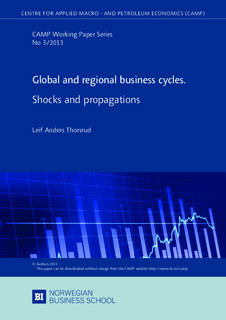| dc.description.abstract | We study the synchronization of real and nominal variables across four dfferent
regions of the world, Asia, Europe, North and South America, covering 32 different
countries. Employing a FAVAR framework, we distinguish between global and
regional demand and supply shocks and document the relative contributions of
these shocks to explaining macroeconomic
uctuations and synchronization. Our
results support the decoupling hypothesis advanced in recent business cycle studies
and yields new insights regarding the causes of business cycle synchronization. In
particular, global supply shocks cause more severe activity
uctuations in European
and North American economies than in Asian and South American economies,
whereas global demand shocks shift activity in the different regions in opposite
directions at longer horizons. Furthermore, demand shocks play a larger role than
that found in related studies. Finally, only innovations to the Asian activity and
price factors have significant spillover effects on shared global factors, demonstrating
the growing importance of Asia in the global economy. | nb_NO |
